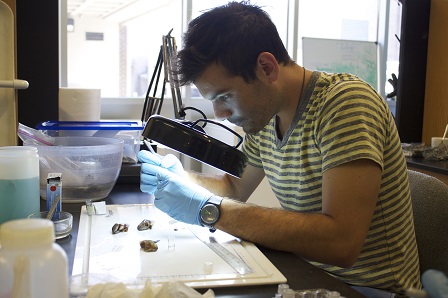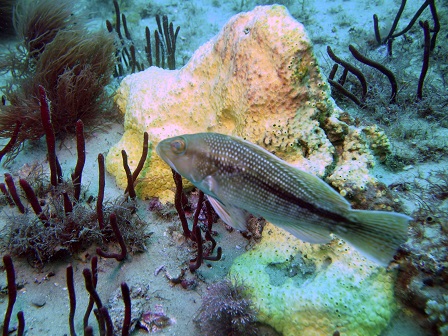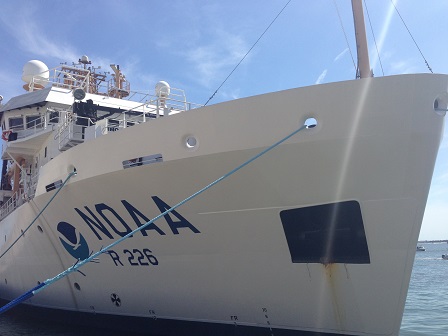By IAN KROLL
Ian Kroll is a National Oceanic and Atmospheric Administration’s Fisheries/National Sea Grant College Program graduate fellow in marine population dynamics. As a toddler, he was terrified of the ocean, convinced that every fish in the great blue was on a mission to nibble off his toes. Fortunately, this fear was quickly replaced with fascination through SCUBA diving and observing fish. His current research combines mathematics, elemental chemistry and resource management. Kroll is a doctoral student in marine science at the University of North Carolina at Chapel Hill’s Institute of Marine Sciences.
My alarm wakes me at 6 a.m. and I roll over, briefly forgetting where I am in my half-conscious state. The steep pitch of the ship, which almost jolts my body off the top bunk, reminds me.

A study-abroad program in college cemented Ian Kroll’s interest in fisheries science. Photo by Emily Woodward
This is the second day of the Southeastern Fisheries Independent Survey marine research cruise aboard the National Oceanic and Atmospheric Administration Ship Pisces. Outside, the ship navigates the waters offshore North Carolina. Inside, I navigate my dark cabin and sneak out the door, trying not to disturb my roommate, who has only just returned from his midnight shift.
My tasks this morning include baiting traps with once-frozen menhaden that thawed overnight. Trying to mask my inexperience with enthusiasm, I forego gloves and reach my bare hands into the sticky, smelly buckets of menhaden and unnamed goo.
The smile on my face serves to maintain my eager façade, but also allows me to avoid breathing through my nose.
This is part of my work as a NOAA Fisheries/National Sea Grant College Program’s graduate fellow in marine population dynamics. I am researching how use of habitat by juvenile black sea bass, or Centropristis striata, affects how quickly the fish grow and reach sexual maturity.
Researchers have long understood that black sea bass, along with many other fishes within the South Atlantic snapper grouper complex, are spawned offshore in spring, where larvae develop. As juveniles, they move inshore, where they gain access to food and shelter in estuarine nursery habitats. At the end of the summer, they move back offshore.
Nursery habitats for black sea bass include sea grass beds, oyster reefs, and bridge and dock pilings. All these areas are present in inshore, estuarine environments. However, anecdotal evidence from fishermen, as well as recent surveys from government organizations, have indicated that juveniles also are present offshore on rocky, open coast reefs or even artificial reef structures made of cement.
This evidence not only complicates scientists’ traditional view of the black sea bass life cycle, but it also brings up two questions: (1) How much of the adult population is sustained by inshore versus offshore nursery habitats? and (2) Do these early habitats confer different benefits over the lifetime of the fish?
It is in pursuit of these questions that I found myself out to sea, knee deep in fish guts.
LEND ME AN EAR
To answer my question regarding preferred habitat, I needed the fish to lend an ear, or rather an inner ear.
Fish ear bones, also known as otoliths, function similar to black boxes or flight data recorders on airplanes. They allow researchers to retrace the movements of individual fish.
As fishes journey through different waters, otoliths record unique chemical signatures, or fingerprints, of those water bodies by incorporating distinct elements from the environment into the structure of the bone.
Scientist can extract these signatures and group fishes that exhibit similar fingerprints, most likely a result of growing up in the same environment.
For my study, signatures from black sea bass juveniles caught in inshore nurseries were compared with those from juveniles caught in offshore nurseries in order to establish a “library” of known signatures.
This is where the Pisces research trip comes in. Overall, we trapped almost 6,000 fishes, 1,633 of which were black sea bass. I was able to take more than 350 adult sea bass otolith samples to the lab for analysis.
I identified the elemental signatures of their juvenile portions, and then used statistical models to match them to my library and identify the most likely nursery, whether inshore or offshore.
Otoliths can be used to answer the question of whether different nursery habitats can be beneficial to the fish later in life. These benefits, aptly named carry-over effects, exist for many species.
For example, medical research shows that children who grow up in an area with high levels of air pollution are more likely to develop asthma, even if they do not remain in their hometown. Conversely, these carry-over effects also can be beneficial. A child who grew up in a town with cleaner air may be less prone to asthma.
As black sea bass grow, their otoliths also record age and growth rate in a manner very similar to tree rings. The bone forms a series of microscopic daily rings that, in turn, comprise larger yearly ones, which are visible under a microscope.
Using the width and spacing of these rings, I can compare juvenile and post-juvenile growth rates of sea bass from various nurseries. This enables me to determine whether nursery habitat affects how quickly a fish reaches harvestable size.
We also can pair this information with samples of black sea bass sex organs to compare estimated time to sexual maturation among fish using the different nurseries.
A MILLION-DOLLAR FISH(ERY)
My first introduction to black sea bass was when I moved to eastern North Carolina. I explored the new-to-me estuarine systems and acquainted myself with the resident fish species in the local style: fishing.
While fishing off a dock one day, I pulled up a mysterious grouper-looking fish with black scales and, as I found out quickly, very sharp dorsal spines.

This black bass was found on a natural reef located in waters off North Carolina at a depth of 15 meters. Photo by Avery Paxton/UNC Institute of Marine Sciences.
An onlooker helped me identify this as a juvenile black sea bass. He shared a story about the first time he caught a black sea bass while fishing with his father way back when.
I took a picture, threw it back and cast out again. Within minutes, I was pulling up another and then another and yet another.
At the time, I was more interested in where these fish came from and where they were going. However, this fish tale was a perfect introduction to the multifaceted value of black sea bass.
Black sea bass are of great cultural, recreational and commercial importance not only to North Carolina, but also to the entire South Atlantic coast of the United States. Many people, locals or otherwise, have stories of growing up catching black sea bass.
The cultural value of these fish increases when considering their frequent appearance — sometimes called black bass, blackfish or even just as sea bass — on local restaurant menus. The sea bass recreational and commercial fisheries also make a significant economic impact.
Last year, recreational anglers from across the country came to North Carolina for the thrill of the catch, landing more than 132,000 pounds of black sea bass in oceans and estuaries.
Commercially, more than a half-million pounds of black sea bass were caught in North Carolina in 2014, equating to about $1.4 million dollars at market and representing half of the black sea bass catch in the South Atlantic.
Although the black sea bass fishery now seems to be thriving, this has not always been the case. These fish became federally managed in 1996 after stock-assessment scientists declared the species as being overfished.
Through the successful implementation of size, gear and take limits for the recreational and commercial fisheries, the stock was declared rebuilt in 2013. However, recent assessments show that landings have still not recovered to their historical highs. Additional monitoring and research are necessary to ensure the population’s continued recovery.
While gear limits and restrictions on harvest can be particularly effective, they only address fishing-specific pressures on individual species and ignore wide-scale issues, such as the global loss of coastal habitats, including important nursery areas.
A HOUSE DIVIDED?
I still am analyzing the data, but preliminary results show that roughly 96 percent of the fish we caught can be traced back to inshore habitats. This means that although the traditional line of thinking that fish use these inshore habitats is generally true, there are some juveniles accessing offshore nursery habitats.

In the two weeks he spent on the “Pisces,” Kroll formed close relationships with other scientists. Photo by Ian Kroll.
In addition, although I have yet to determine the presence of carry-over for these habitats, early results suggest that greater conservation efforts focused on inshore, estuarine nurseries may be needed to ensure the future of our fisheries.
Offshore habitats, however, also may benefit from greater protections in order to further bolster fishery yields.
Use of nursery habitats, whether inshore or offshore, is not unique to black sea bass, but rather common among other commercially important species, such as lane snapper, gray snapper, summer and southern flounder, and gag grouper. It follows, then, that a percentage of these fishes also may use offshore habitats. Therefore, management strategies that focus on preserving or protecting inshore and offshore habitat may benefit multiple species.
In the coming months, I will extract the answers to these valuable research questions, one otolith at a time.
I also want to foster the relationships with the NOAA fisheries scientists that I met onboard the Pisces into potential collaborations, as well as to participate in future cruises. A special camaraderie develops when 12 people share close quarters for two weeks.
While sitting in lab, I cannot help but hope my future research will take me back out to sea, giving me a chance to master my sea legs again soon.
And this time, I will even ask for gloves.
This article was published in the Holiday 2015 issue of Coastwatch.
For contact information and reprint requests, visit ncseagrant.ncsu.edu/coastwatch/contact/.
